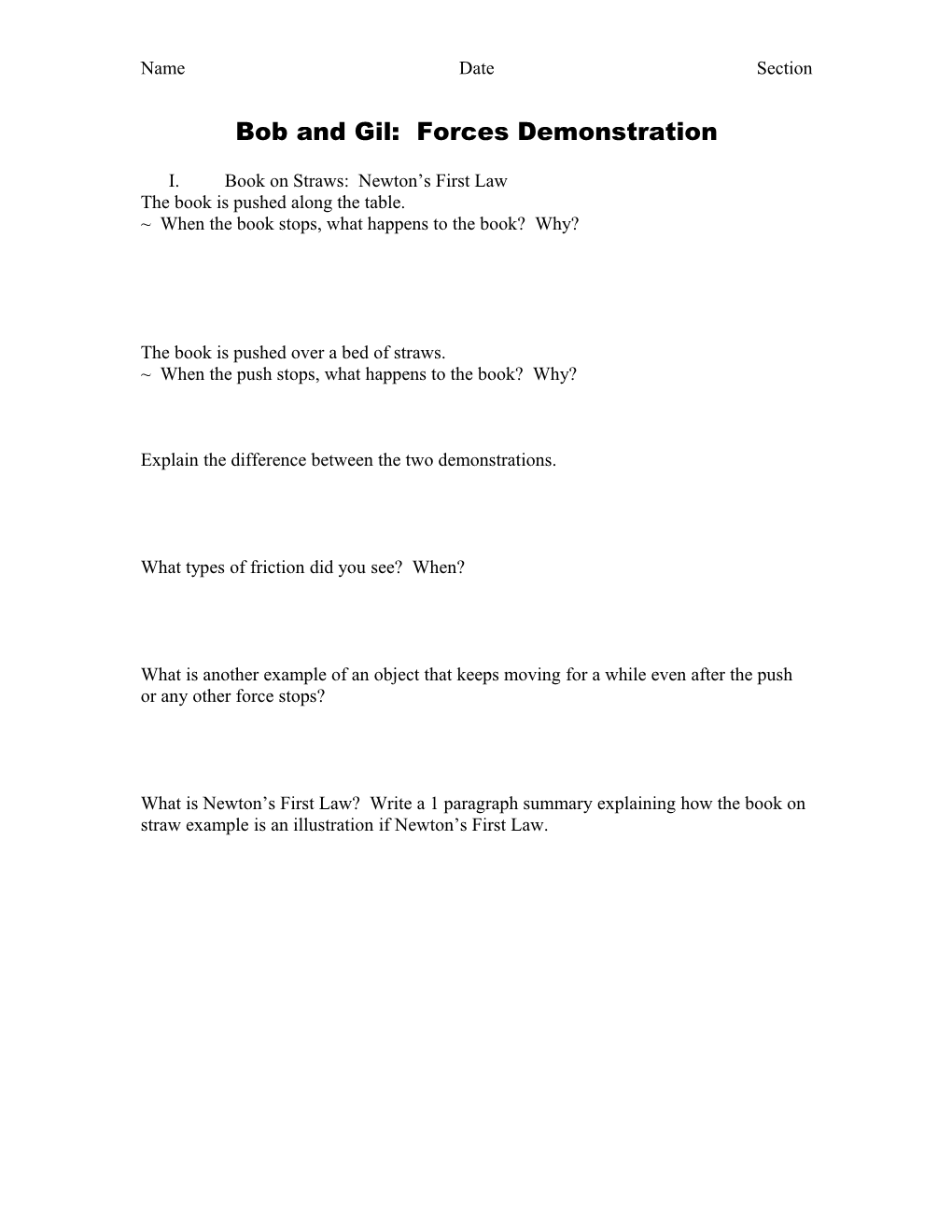Name Date Section
Bob and Gil: Forces Demonstration
I. Book on Straws: Newton’s First Law
The book is pushed along the table.
~ When the book stops, what happens to the book? Why?
The book is pushed over a bed of straws.
~ When the push stops, what happens to the book? Why?
Explain the difference between the two demonstrations.
What types of friction did you see? When?
What is another example of an object that keeps moving for a while even after the push or any other force stops?
What is Newton’s First Law? Write a 1 paragraph summary explaining how the book on straw example is an illustration if Newton’s First Law.
II. Free Fall of a Book vs a Piece of Paper
Test One – Book in one hand, paper in the other hand. Drop at the same time.
a. Predict: Which will hit the ground first?
b. Observe: What happened?
Test Two – Put paper under the book. Drop them together.
a. Predict: Which will hit the ground first?
b. Observe: What happened?
c. Analyze: Why did this happen?
Test Three: Put paper on top of the book. Drop them together.
a. Predict: Which will hit the ground first?
b. What happened?
c. Analyze: Why did this happen?
Test Four: Crumple up paper. Book in one hand, paper in the other. Drop at the same time.
a. Predict: Which will hit the ground first?
b. Observe: What happened?
Test Five: Object Used: ______
a. Predict: Which will hit the ground first?
c. Observe: What happened?
Summary: Write a paragraph on what you learned about Newton’s Second Law – mass and acceleration.
III. Mass on a Thread: Inertia
Draw and label a diagram of the demonstration.
If we give the bottom thread a quick jerk what happens?
Why does this happen?
What is inertia?
IV. Buoyant Force: Newton’s 3rd Law
Label the following diagram of the demonstration.
Predict:
~ What do you think will happen to the reading on the spring scale (clay’s mass) when the clay is submerged in water?
~ What do you think will happen to the mass reading triple beam balance after the clay is submerged in the water?
Mass Before and After clay is submerged in the water.
Mass (g) Before clay is dropped into the water / Mass (g) After clay is dropped into the waterClay (spring scale)
Water Beaker
(triple beam balance)
Analyze:
What happened to the reading on the spring scale when the clay was submerged in water?
What happened to the reading on the triple beam balance when the clay was submerged in water?
Explain why this happened.
Draw and label the forces that are involved.
The forces are equal and opposite: The spring scale reading decreases by ______g.
The triple beam balance reading increases by ______g.
V. Falling Coffee Filters: F = ma (Newton’s Second Law)
Procedure:
1. Measure the time it takes for a coffee filter to fall a distance of 2 meters.
2. Increase the mass. (number of coffee filters)
3. Take 3 time measurements for each mass.
4. Record the data in the chart.
5. Calculate the average velocity.
6. Create a graph of the average velocity in # of coffee filters.
Average Velocity = Distance
Average time
Number of Coffee Filter / Time (sec) / Average Time (sec) / Average VelocityV = d/t
1
2
4
8
10
1. Look at the data chart. As the mass of the coffee filters increased, what happened to the time it took for the filters to fall 2 meters?
2. Create a graph on the back-side of this paper. X – axis = # coffee filters
Y – axis = Average Velocity
3. What do you think would happen if we used 50 coffee filters? 100 filters?
4. Write a 2-3 sentences conclusion about this experiment and Newton;s 2nd law.
